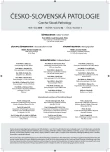Skin cell response after jellyfish sting
Authors:
Katarína Adamicová 1; Desanka Výbohová 2; Želmíra Fetisovová 3; Elena Nováková 4; Yvetta Mellová 2
Authors‘ workplace:
Ústav patologickej anatómie Univerzita Komenského Bratislava Jesseniova lekárska fakulta Martin a Univerzitná nemocnica Martin
1; Ústav anatómie Univerzita Komenského Bratislava Jesseniova lekárska fakulta Martin
2; Dermatovenerologická klinika Univerzita Komenského Bratislava Jesseniova lekárska fakulta Martin a Univerzitná nemocnica Martin
3; Ústav mikrobiológie Univerzita Komenského Bratislava Jesseniova lekárska fakulta Martin
4
Published in:
Čes.-slov. Patol., 52, 2016, No. 1, p. 55-60
Category:
Original Article
Overview
Introduction.
Jellyfish burning is not commonly part of the professional finding in the central Europe health care laboratory. Holiday seaside tourism includes different and unusual presentations of diseases for our worklplaces. Sea water-sports and leisure is commonly connected with jellyfish burning and changes in the skin, that are not precisely described.
Aim.
Authors focused their research on detection of morphological and quantitative changes of some inflammatory cells in the skin biopsy of a 59-years-old woman ten days after a jellyfish stinging. Because of a comparison of findings the biopsy was performed in the skin with lesional and nonlesional skin.
Methods.
Both excisions of the skin were tested by imunohistochemical methods to detect CD68, CD163, CD30, CD4, CD3, CD8, CD20 a CD1a, to detect histiocytes, as well as several clones of lymphocytes and Langerhans cells (antigen presenting cells of skin), CD 117, toluidin blue and chloracetase esterase to detect mastocytes and neutrophils. Material was tested by immunofluorescent methods to detect IgA, IgM, IgG, C3, C4, albumin and fibrinogen. Representative view-fields were documented by microscope photocamera Leica DFC 420 C. Registered photos from both samples of the skin were processed by morphometrical analysis by the Vision Assistant software. A student t-test was used for statistical analysis of reached results.
Results.
Mean values of individual found cells in the sample with lesion and without lesion were as follows: CD117 -2.64/0.37, CD68-6.86/1.63, CD163-3.13/2.23, CD30-1.36/0.02, CD4-3.51/0.32, CD8-8.22/0.50, CD3-10.69/0.66, CD20-0.56/0.66, CD1a-7.97/0.47 respectively. Generally mild elevation of eosinofils in lesional skin was detected. Increased values of tested cells seen in excision from lesional skin when compared with nonlesional ones were statistically significant in eight case at the level p = 0.033 to 0.001. A not statistically significant difference was found only in the group of CD163+ histiocytes.
Conclusion.
Authors detected numbers of inflammatory cells in lesional skin after the stinging by a jellyfish and compared them with the numbers of cells in the nonlesional skin of the same patient. Statistically significant differences were seen in the level of selected inflammation cells and numerically documented changes of cellularity in the inflammatory focus were caused by a hypersensitivity reaction after jellyfish injury in the period of 10 days after attack.
Keywords:
jellyfish burn – jellyfish sting – contact dermatitis – morphometry
Sources
1. Kingston CV, Southcott RV. Skin histopathology in fatal jellyfish stinging. Transaction of the Royal Society of tropical Medicine and Hygiene 1960; 54(4): 373–384.
2. Drobina BJ, Lee C. Jellyfish sting. 2013; http:// www.emedicinehealth.com/jellyfish_stings/ article_em.htm
3. Klauzová K. Jizvy z dovolené – medúzy. Referátový výber z dermatovenerológie 2013,v4: 8–13.
4. Burnett JW. Human injuries folloving jellyfishvsting. Md Med J 1992; 41(6): 509–513.
5. Al-Rubiay KK, Al-Musaoi HA, Alrubaiy L, Al-vFreje MG. Skin and systemic manifestationsvof jellyfish Stings in Iraqi fishermen. LJM 2009; 4(2): 75–77.
6. Uri S, Marina G, Liubov G. Severe delayed cutaneous reaction due to Metiterranean jellyfish (Rhopilema nomadica) envenomation. Contact Dermatitis 2005; 52: 282–328.
7. Daubert GP. Cnidaria envenomation. 2012; http://emedicine.medscape.com/article/ 769538-overview#a0104.
8. Ghost SK, Bandyopadhyay D, Haldar S.Lichen planus-like eruption resulting from a jellyfish sting: a case report. J Med Case Reports 2009; 3: 7421.
9. Chang D, Dattaro JA, Yakobi R. Jellyfish stings. emedicine 2008.
10. Rallis E, Limas C. Recurent dermatitis after solitary envenomation by jellyfish partially responded to tacrolimus ointment 0,1%. JEADV 2007; 21: 1287.
11. Menahem S, Shvartzman P. Recurent dermatitis from jellyfish envenomation. Can Fam Physician 1994; 40: 2116–2118. 12. Lee NS, Wu ML, Tsai WJ, Deng JF. A case of jellyfish sting. Vet Hum Toxicol 2001; 43(4): 203–205.
13. Chromej I. Atopický ekzém. Banská Bystrica: Dali – BB; 2007: 240.
14. Maniecki MB, Etzerodt A, Moestrup SK, Moller HJ, Graversen JH. Comparative assessment of the recognition of domain-specific CD163 monoclonal antibodies in human monocytes explains wide discrepancy in reported levels of cellular surface CD163 expression. Immunobiology 2011; 216(8): 882–890.
15. Tibballs J, Yanagihara AA, Turner H, Winkel K. Immunological and Toxinological Responses to Jellyfish Stings. Inflammation and Allergy – Drug Targets 2011; 10(5): 1–9.
Labels
Anatomical pathology Forensic medical examiner ToxicologyArticle was published in
Czecho-Slovak Pathology

2016 Issue 1
Most read in this issue
- Serrated adenomas and carcinomas of the colon
- Morphology of the gastroesophageal reflux disease
- Follicular and mantle cell lymphoma diagnosed in biopsies of gastroenterocolic region
- Skin cell response after jellyfish sting
